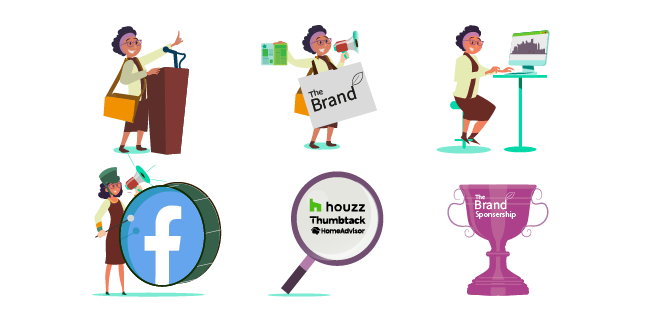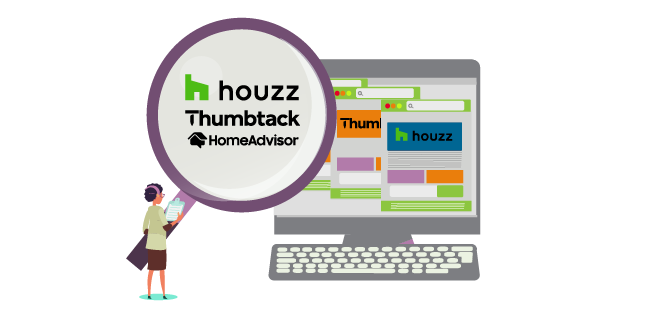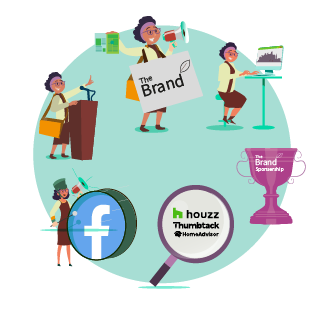For the architecture profession, the days of securing work through word-of-mouth recommendations or the strength of your portfolio are long gone.
Not only has the technology revolution of the past few years driven more clients to research potential firms online. But it’s also increased the amount of competition which comes against you.
And yet, despite this shift in dynamic, it’s still rare for small-to-medium-size firms to implement an architecture marketing strategy. Let alone as part of their daily operations.
Is it any surprise?
Between attending meetings, responding to enquiries and working on actual projects, it can be near impossible to find the time. Most architects struggle to find time to sit down and work out how to build a book of potential business.

Add to that, the fact that most architects aren’t trained marketers. So the thought of creating an actual strategy can seem hugely daunting or overwhelming.
The truth is, marketing can be overwhelming at first. There are so many ideas out there as to how you can best reach and promote your firm to prospective clients. As such, it’s difficult to know what to begin with.
Take a look at 6 architecture marketing ideas. Especially if you’re looking for some quick and sure-fire ways to start getting more clients through the door
Each of them can be effective in driving short-term interest in your business. And when used as part of an overall marketing strategy, they have the potential to make long-term positive business impacts. Thus, keeping your firm one step ahead of the competition.
6 Marketing Ideas to Help Your Architecture Firm Gain More Clients

Before we launch into some of the ideas which can help you grow your client base, we need to establish one major thing: there isn’t one quick fix that will gain you instant exposure.
With online and offline marketing channels having become increasingly saturated over the years, it’s hard to stand out.
You need to prepare to put in a lot of time and effort to create omnipresence. This is essential to ensure your marketing and architecture efforts are being seen and heard over your competitors.
Instead, you need to adopt a long-term strategy, with actionable goals to help you grow and increase your client base. While the suggestions below are for sparking new campaign ideas are great. They only make up a part of your overall strategy.
Combine them with a robust SEO and content marketing strategy for optimum success. Then, you’ll be well on the way to getting your architecture firm seen and heard by even more people.
1. Attend or Take Part in Industry Conferences
Attending an architecture conference, or one related to your brand’s niche, is an easy way to meet prospective clients. As well as being a great way to network with other brands and scope out the competition.
There are plenty of architecture conferences taking place over the next few years, both in the UK and internationally. You can easily find them yourself too. Either by conducting a quick Google search or by signing up to the newsletters of mainstream architecture publications and events.
When you attend these conferences, spend the day networking with as many prospective clients as possible. Meeting people face-to-face is by far the best way to convert your leads and can result in unexpected opportunities.
For better brand visibility, you could even hire a pitch at the conference and draw people to your stand.

Having a pitch at a large-scale conference isn’t just a great way to get your branding seen by more prospective clients. But having quality printed materials available to hand out can establish your authority as a professional brand. Rather than seeing you as an individual attendee, people will admire you as a brand with authority.
If relevant, you could also sign-up to do a public speech or presentation at the conference. This would give you an opportunity to stand in front of a large, engaged, audience. In addition, you can position yourself as a thought leader.
Use your presentation as a way to provide value to your audience.
Teach them something they didn’t already know with your insider knowledge. It’s the easiest way to suspend potential clients into trusting you as an in-demand expert. They will naturally feel more inclined to work with you as a result.
On top of attending physical conferences, don’t forget to also look at opportunities to attend virtual conferences. Alternatively, participate in webinars or relevant podcasts.
Not only can these save you a lot more time – perhaps only needing to take 1-2 hours out of your working day. But they’re also great at improving your online visibility. With the host websites and their relevant social media accounts mentioning your brand. Often resulting in a backlink to your website.
Although it may seem like a daunting prospect at first. By positioning yourself as an expert in this way, you’ll be changing the dynamic of your marketing. Instead of looking to grow your leads, you’ll have clients coming directly to you. Especially after seeing you as a brand with authority and valuable knowledge.
2. Write & Publish Articles
As an effective PR tool, writing and publishing articles in your area of expertise can help your brand visibility. It’s a way to get noticed by a large number of prospective clients and will establish you as an expert.

Whether you look for publishing opportunities in traditional printed media such as newspapers, magazines, and local booklets. Or, online with industry-relevant blogs, news sites and e-zines. Overall, there’s plenty of places to get your brand seen and heard.
In order to get your writing published in this way, your initial work will need to focus on building relationships. These will likely be with journalists, editors, and blog owners relevant to architecture or your niche.
Once you have a good network of prospective publications, spend the time pitching your articles to them. Then, write the copy and issue them with a final press release.
As long as you have a great story or angle with which to position your writing, traditional and digital PR can be a rather lucrative return on investment. The strategy is often very low cost (or mostly free) for organisations. But it can draw in a mass of potential clients.
Not only will you have your brand’s name splashed across some potentially high-profile publications. But you can also earn valuable backlinks from online publications. And these will help to improve your website’s overall SEO rankings and visibility.
If possible, aim to get your articles in a variety of industry-related publications, both online and offline. It’s the only way to ensure your work is being seen by a large demographic of readers.
In addition to this, the more publications you can get your work seen in, the more admired you will be. Not only as a brand, but as a figure of authority. And because of this, you will naturally see more clients approach you with work.
Don’t forget that you can also repurpose some of these PR articles and use them within your overall architecture marketing strategy. Use them within your content marketing, emails, and even social media to share your expertise with your clients. You’ll save time and share valuable knowledge with your audience too.
3. Get Loud on Social
Did you know that 9 out of 10 B2B companies are currently using the professional networking platform, LinkedIn? And 76% are on Facebook?
More than half of B2B buyers agree that these platforms helped them to make a purchasing decision over the past year. As such, they really are the go-to platform for those looking to reach new clients online.
If you’re already an established brand or marketer on the platforms, don’t be afraid to directly ask your network if they are aware of anyone who may be considering a project.
It may feel a little uncomfortable to do. But if you have a strong network then you may be able to pick up some good projects quickly.
Putting out a quick update takes minutes to do and doesn’t cost anything. Even if nothing comes of it, it’s a good way to catch up with your network. Or share updates with one another.
However, if you aren’t established yet or don’t have a big following on your firm’s social media: don’t panic! There are some quick and easy ways to get ahead on social media.
One way to do this is by promoting one or two posts with a little spend to reach a larger audience. On LinkedIn, these are called ‘sponsor page updates.’ While Facebook and Instagram call them ‘boosts.’

For quick, fast responses, boosting posts can be really beneficial. They allow you to put your brand’s services in front of new audiences on their social media.
When you boost a post, you will be asked a number of questions to ensure your promotion works in the way you want it to.
This includes:
- Your budget for the ad
- The geographic data for the audience you want to reach
- Your audience psychographic data
There are plenty of options to choose from, such as their age, interests, and profession, allowing you to get really specific with the audience you target. While the budget prevents you from spending more than you wish to when boosting the post. You can also choose to boost a post anywhere from a few hours to a few weeks in length. Therefore giving you total flexibility in how long the campaign runs for.
Make sure the post you’re boosting outlines your main unique selling points (USPs). As well as a clear call-to-action so prospective clients know how to get in touch with you. This post may be the first time they have ever seen or heard of your brand. So make sure the post helps show your brand in the best light.
Alternatively, you could also look to run a longer advertising campaign with a multitude of posts. Currently, Facebook Ads is the best developed platform out of all the social media platforms available. This is due to its popular active monthly user base of 2.6 million people.
However, you can choose to use LinkedIn’s Campaign Manager if you feel it is most appropriate for reaching your target audience.
Running advertising campaigns involves more steps than simply boosting a post. They tend to be longer campaigns. And they require you to pick an overall goal that you want the platform to work towards.
For example, you could set the goal of ‘lead generation’ which would optimise your ad to encourage more clicks. Alternatively, selecting the ‘brand awareness’ goal would tell the platform to use your spend trying to reach as many interested audience members as possible.
Just like boosting posts, you will still be asked to set budgets and refine your target audience. Thus, ensuring your ads are as effective as they can be and are shown to the most appropriate audiences.
Although they require a more long-term mindset, running advertising campaigns can help to achieve your overall digital marketing goals. Rather than quickly boosting posts for short-term success.
For example, if your overall goal for digital marketing this year is to generate 500 leads. Then setting up a campaign on your LinkedIn or Facebook which aims to do this can be one method of increasing your leads. You may do this in conjunction with targeted email marketing and content marketing. As well as website optimisation to improve the fluidity with which visitors can complete a particular user journey. For example, when they submit an enquiry form.
Whether you choose to reach out to your established network or run and advertising campaign, it doesn’t really matter. Social media is such an established presence in almost every modern-day consumer. So your main priority needs to be getting yourself on these platforms. As well as posting consistently to ensure your brand is seen and heard.
4. Consider a Lead Generation Service
If you’re short on time or don’t feel comfortable managing your ads yourself, consider using a lead generation service.
As the name suggests, a lead generation service is a company that specialises in finding new clients for businesses. Typically, this involves running online search engine marketing (SEM) campaigns that target relevant audiences in the local area.
Let’s say you were an architecture firm based in Cambridge looking to gain new clients. You may use a lead generation service to target prospective clients in your city. So, if someone were to type ‘architects in Cambridge’ into a search engine like Google, they would see an advert promoting your business.

Then, if someone were to click on that ad, they would be taken to a page which asks them to enter information about their query. For instance, the type of project they’re planning, as well as their contact information.
The information of that searcher would then be sent to the architecture firms which have paid to use the service. As a result, they can then follow up and strike up a conversation with the prospective client.
This conversation is the crucial stage in converting them into clients. Companies such as Houzz.com, HomeAdvisor.com and Thumbtack.com all specialise in lead generation services. But they aren’t exclusive with the firms they work for.
This means that you may not be the only architecture firm signed up to their business. As such, you will be competing for the same leads. Therefore, you need to be the quickest, best suited, and most compelling firm if you are to beat your competitors.
Although it takes a lot of follow up work to convert the client. The use of lead generation services is one of the quickest ways to capture new prospects.
It’s also important to note that just because you’re paying, it doesn’t mean that the lead quality is going to be high. The companies running these ads have no control over the individuals submitting their enquiries. Therefore, you may not know the likelihood of whether that lead will convert until you’ve engaged them in conversation.
With that being said, they can also be a goldmine in terms of potential clients. As they specialise in lead generation within your local area. So when you do discover a serious contender, chances are they’re going to be a great addition to your business.
Don’t Underestimate Word of Mouth
Word of mouth is possibly one of the most lucrative marketing channels – 64% of marketing executives agree.
Particularly for those with a local presence.
Having your brand’s name passed around local B2B businesses will build your authority in the local area.
And in the long-term, your brand will be recognised as the go-to business. The more local business you can get, the stronger your position within the local market.
You can encourage this trend by asking existing clients for referrals and reviews online.
Therefore, if you find a prospective local client this way, work as hard as you can to secure their project.
That way you’ll have the edge over your competitor.
5. Sponsor Local Events
Another way to help your architecture firm get noticed by prospective clients is to sponsor local events and charities.
Although this requires an upfront cost, it’s an effective strategy to get your architecture firm noticed within the local community. As well as help a local cause which you and your firm are passionate about.

Aside from the obvious word of mouth benefits that are associated from using this marketing strategy. In addition, you can also relish some digital benefits from it too.
For example, if you sponsor a local charity, that charity will likely mention your sponsorship on their website. As well as on their social media. As such, you will obtain a backlink for your site. But you’ll also get your firm seen by their audience too.
Online, this can be invaluable. You’ll build a link profile that can help to boost your SEO rankings, whilst getting free shoutouts from local brands.
Now, this may not be the quickest tool in your arsenal for building your client base. But it will contribute to your long-term architecture marketing goals.
In the end, it’s all about being the name on the tip of the tongue for anyone looking for an architecture firm. If you can get to the stage where your brand is being seen everywhere your prospective clients are. Then they’ll be more inclined to choose your firm to work on future projects with.
6. Contact Previous Leads
Now, this point is only valid if you are an established architecture firm. Or one which has been involved in marketing for at least a short while. But, even if you are a newbie to marketing for your architecture firm, make note of this important tactic.
Over the years, as your marketing strategy grows and evolves, you will capture and grow a significant database of leads: both prospective and closed.

Holding onto the contact details of your closed leads is extremely valuable. As you may be able to convert these leads at a later date.
Just remember to make a note as to why your leads never converted. Was it because you didn’t have the resources available to deliver their project on time? Or were they completely out of your price range? This will stop you from having any awkward conversations.
If you’re looking for a quick way to get more clients, consider reaching out to your unconverted prospects. You can do this by writing them an email or calling them.
It doesn’t need to be long, just a simple; ‘are you still considering your project?’ will do. After all, with the average marketing email sitting at 434 words in length, I’m sure your prospects will appreciate conciseness. It’s direct, gets to the point, and most importantly, starts the conversation.
I know a lot of people are hesitant to do this, and many consider it to be a ‘clutching at straws’ approach. But if you don’t ever follow up on your long list of cold leads, you will never know if you could have worked together.
You never know, that one courtesy call could be made to the right client at the right time. And could lead to some great business.
Summary
For architecture firms looking to get clients through the door quickly, there are a number of quick marketing tactics you can use. Both online and through face-to-face conversation.
Implement any of them and you will see how they can help make a difference for your firm in the short-term. But if you want to create a long-lasting impact that will continue to drive leads to your business. Then you need to consider implementing them as part of your overall marketing strategy.
Creating a long-term strategy will make the difference between always chasing cold leads for prospective projects. And having a long list of clients who are waiting to work with you.
As a B2B profession, architecture is based on building relationships with clients. They need to be able to trust that you will deliver a high-quality job. But, as with any relationship, it takes time and effort to gain that trust. With clients needing a guarantee that you are the best business for them to turn to.
Therefore, if you want your firm to succeed in today’s saturated market, focus on creating and implementing an effective marketing strategy. One which encompasses content, SEO, as well as other offline marketing channels.
Only once you have done so will you become an omnipresent firm. A firm which everyone recognises as being a market leader and the go-to for carrying out their projects.
Thinking of Outsourcing Your Architecture Firm’s Marketing to a Marketing Consultancy?
As we’ve established, for your firm to go from a small-to-medium sized business to one of the best on the market, you need to create and deliver a robust architecture marketing strategy.
This of course is a hugely time-consuming task. In fact, it’s one which requires a complete overhaul of your current practices. As well as the implementation of new channels and resources. When it comes to marketing, there’s no room for cutting corners. And you really need to dedicate the time in order to make it a success.
Unsurprisingly, most architecture firms don’t have the capacity or resources to do such work in-house. So they often turn to a marketing consultancy like ours to assist with their strategy.
With the team and expertise needed to establish an easy-to-implement plan, we can help. We’ll assist you in adopting a number of marketing strategies, such as content marketing and SEO. To help you stand out against the competition and drive more leads to your website.
If you would like to find out more about the type of work we do, and how we can help you to achieve your marketing goals, please get in contact. I’d be happy to have an obligation-free chat with you, find out more about your firm, and where we may be able to assist.




